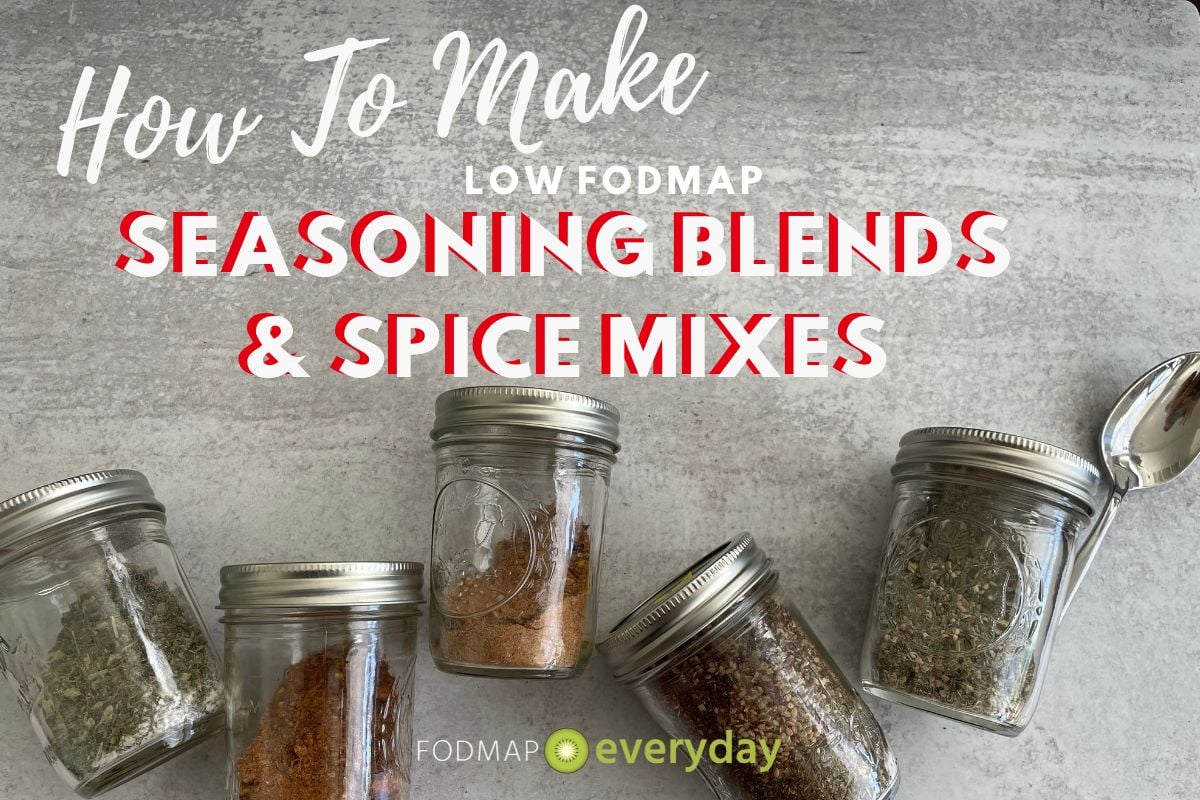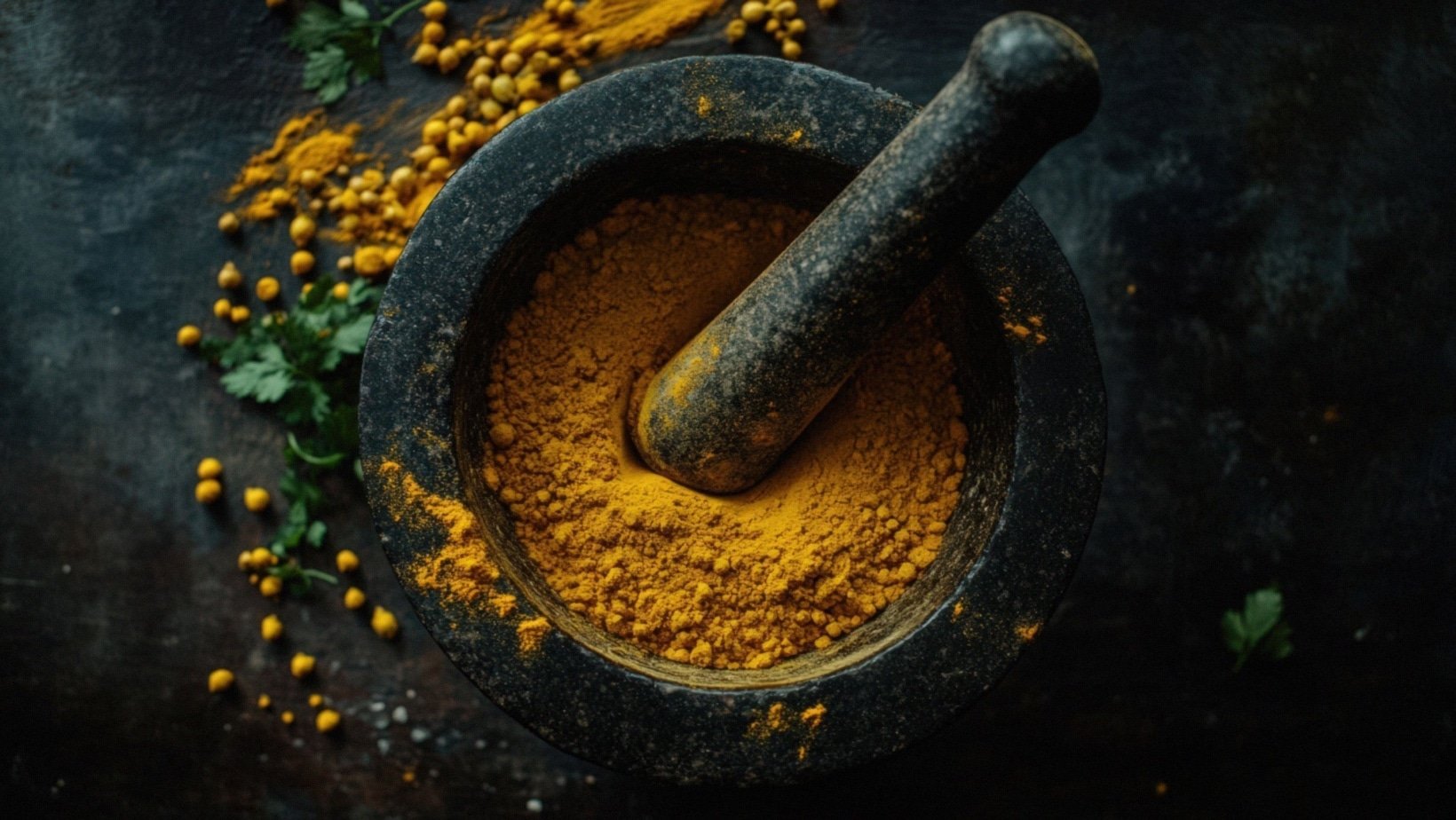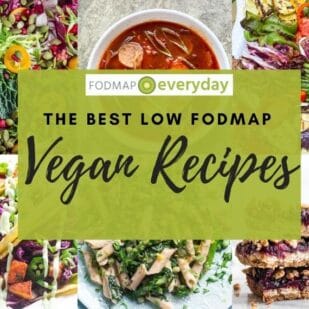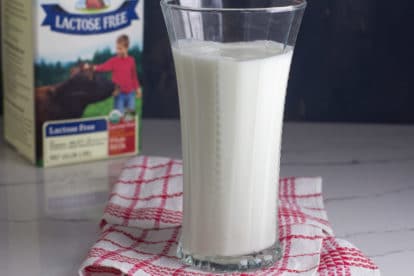Here are our tips for making easy, flavorful-packed digestion friendly, low FODMAP seasoning blends and spice mixes – and links to 15+ different ones that we have whipped up just for you.

If you have IBS and are transitioning into a low FODMAP diet to get your symptoms under control it can be overwhelming as is, without worrying about maximizing flavor on top of it all. Once you’ve settled into the basics of the low FODMAP Elimination Phase, you might be feeling ready to ramp up the spice and get creative with low FODMAP culinary swaps.
If this sounds like you, you’re in the right place!
So, grab your mason jars and measuring cups and spoons, and let’s dive into our best DIY tips.
As always, remember that even if a food is considered low FODMAP per a lab test, or we’ve opted to use it based on our interpretation of the evidence-based literature, there is never a guarantee that something might not trigger IBS symptoms. Use your individual discernment and knowledge of your FODMAP tolerance to determine what is best for your body.
Why You Should Make Low FODMAP Seasoning Blends
There are many low FODMAP seasonings available on the market, but maybe they are not to your taste, or are not available where you live? The great thing about making your own is that you can tailor them to your liking. You can make sure that the herbs and spices are of impeccable quality; you can also adjust the flavor, with a little research.
Anytime you make a change to a low FODMAP recipe, you do have to be mindful of the FODMAP load, but this can be easy to determine, and if you want your Taco Seasoning much spicier – or much less – you can please your palate.
Making your own also means saving money, especially if you buy the raw ingredients in bulk. And, they are all very easy to make. Just dump and mix! They make great host gifts, too.
All About Making Low FODMAP Seasonings
In this article, we will outline some of our favorite “fodified” seasoning blends, as well how to prepare them and use them. We’ll also highlight a few ingredients that have not specifically been tested by Monash University and discuss the logic behind why we’ve opted to include them.
As you read through these low FODMAP seasoning blend recipes, you will also notice a couple of ingredients that are frequently used: namely, low FODMAP garlic and onion powder. Yes, that’s right! There are low FODMAP garlic and onion powder replacements; we use Fodmazing and FreeFod brands. We consider these to be kitchen essentials for fun low FODMAP flavor, so peruse your options and be sure to grab some before getting started with your own blends.
There are low FODMAP garlic and onion powder replacements; we use Fodmazing and FreeFod brands.
The FreeFod, by the way, has been lab tested and certified low FODMAP by FODMAP Friendly. The Fodmazing has not been lab tested, but it contains the exact same ingredients.

Purchasing Dried Herbs & Spices
Here’s the deal. You are looking to add flavor to your low FODMAP cooking, and old, stale spices won’t cut it. So, when it comes to purchasing, storing, and re-upping on your spice collection, there are a couple of important things to know.
First, spices do expire. Over time, they lose their smell, flavor, and even nutritional benefits, which is the whole reason we want to use them in the first place! While they’re highly unlikely to make you sick after expiring, they probably won’t be adding much to your recipes after a certain point. As a general rule of thumb, smell your spices before using them. If they smell as you would expect, keep them. If they smell stale or like nothing at all, it’s likely time to purchase anew. (We also give you suggested time frames, below).
Whole vs. Ground
Also, ground spices and dried herbs tend to expire more quickly than whole, pre-ground spices. For example, whole cinnamon sticks, or black peppercorns will have a longer shelf like (around 2-3 years) compared to pre-ground cinnamon (around 6 months to 1 year). Before you embark on whipping up these fabulous low FODMAP spice blends, be sure that the spices and dried herbs you have on-hand to make them with are fresh, so that they pack the flavor and aroma we are really hoping to achieve with these recipes.
Then, after you make your blends, label them with both the name of the blend and the date you made them. Aim to use them within 3 to 6 months of that date, or let your nose guide you on when you need you make a fresh new batch. PS: We are very conservative with our storage recommendations; you might find your spices remaining vital for longer.
One more note on reground spices: we know many of you might buy pre-ground black pepper. We are here to tell you that it cannot compare with freshly ground – at all. The difference is quite dramatic and we do not recommend pre-ground black pepper in any of our recipes. Pre-ground is incredibly dull in comparison. Freshly ground black pepper is a bit spicy, but also aromatic and nuanced. When calling for black pepper, we always call for freshly ground.
Let’s Talk Salt
Salt is a hugely underrated seasoning. Most people do not realize the impact that salt has – but if you have ever had a slice of salt-free bread, you will notice right away. The lack of salt truly stands out and whatever you are eating that is saltless is a mere ghost of what it could be.
Your choice of salt, as well as its inclusion, matters as well. We call for three different types of salt and the specific kind is mentioned in the individual recipes. Please use the kind called for.
- Table salt is simply fine-grained pouring table salt. We use Morton’s.
- Kosher salt is coarser and not only measures differently, but has its own taste, as well. We use Diamond Crystal Kosher Salt.
- Maldon salt is an extra large flaky salt that provides a bright, clean flavor and a ton of crunch.
BTW I do not use “fine sea salt” in the Test Kitchen as I find most of it to have a very aggressive salinity. And I must address pink Himalayan salt, as it has become a commonly found ingredient. I almost want to put prepared products back on the shelf when I see it. Too many companies try to peddle this salt as “better”, and charge you a pretty penny for the honor. The fact is that it does contain some minerals that other salts do not – but in the quantity that any of us use, the health benefit is nil according to our dietitians. Do not be sucked in by marketing.
And if you want salt-free, we have a blend for you, too. Just don’t try and leave salt out of the blends that do contain it.
Measuring Your Ingredients
You will see that you will be giving your tablespoons and teaspoons a workout. Believe it or not, there is a lot to say about measuring equipment. First of all, as we are in the U.S., we use tablespoons that are 15 ml in size (the equivalent of 3, 5 ml teaspoons). In Australia, a tablespoon is 20 ml. We have an article for you to read, When Is A Tablespoon Is Not A Tablespoon? If you are in Australia you will have to adjust our recipes.
Then, we have the matter of the quality of your tools. Believe it or not, your tablespoon might not be accurately made. What do we mean? Table salt was measured and weighed with dozens of sets of measuring spoons and the variations of what came out of those spoons varied by more than 100%! Toss those dollar-store spoons, dented spoons, spoons that look like flowers or hearts…get yourself quality tools and your cooking and baking will actually improve. We use Cuisipro in our Test Kitchen here at FODMAP Everyday®.
We have more info in our article on How To Measure By Volume.
-
Nicewell Food Scale$23.49
-
Greater Goods Nutrition Food Scale
-
OXO Good Grips 5 Pound Food Scale with Pull-Out DisplayProduct on saleOriginal price was: $32.95.$29.79Current price is: $29.79.
-
Cuisipro Stainless Steel Measuring Spoon Set$11.12
-
OXO Good Grips 11 Pound Stainless Steel Food Scale with Pull-Out DisplayProduct on saleOriginal price was: $55.95.$39.00Current price is: $39.00.
-
Cuisipro Stainless Steel Measuring Cup and Spoon Set$40.78
Toasting Spices
Most of the time you will be using your herbs and spices right out of the jar, but sometimes toasting your spices first enhances the finished product.
For example, when preparing a spice blend that involves whole spices (like whole clove, mace, cumin seed, mustard seed, etc.), you may opt to first toast the whole spices over low heat until slightly fragrant, before grinding. While this is by no means a requirement, something truly magical happens when you apply just the right amount of heat to a whole spice before grinding it up to use in a blend!
By lightly toasting the whole spices before grinding to use in a recipe, you coax a greater depth of flavor and aroma out of the ingredients. It is super important to note here that we can go from toasting or spices to burning them very quickly! So, apply only low heat, watch closely, and remove the spices from heat when lightly fragrant. This is a great method to use when preparing more complex spice blends, like the Ethiopian Berbere and Moroccan Ras-al-Hanout blends.
If you opt to save yourself some time upfront by choosing not to toast your whole spices before grinding, fear not! You can just as easily toast your ground spice mix briefly over low heat, before adding it to the recipe you wanted to use it in. This is a great way to maximize the flavor of our Garam Masala recipe, for example.
In some cases, as with the Za’atar herb and spice blend, no heat is needed at all. Simply rubbing the spices between your fingers as you sprinkle it over your desired recipe will do just the trick to release the all oils, aromas, and flavor you want from the blend!

Grinding Spices
When toasting spices, they will most likely be whole. After cooling you will need to grind them. You can go electric or manual. The Cuisinart Electric Spice and Nut Grinder is highly rated, easy to use and the bowl is dishwasher safe.
The Krups Electric Spice and Coffee Grinder is another recommendation, also moderately priced. The bowl is static, but it is easy enough to clean.
We do not suggest that you use your coffee grinder for spices or vice versa. It is very hard not to have some carryover of flavor from coffee to spices and back again.
You can also go old-school with a mortar and pestle. It takes some elbow-grease (such a weird term) but works.
We cannot say enough about the PepperMate grinder, which we use as a dedicated black pepper grinder (they make great presents, BTW). It is the one we use in the FODMAP Everyday Test Kitchen because it is easy to fill, with a wide opening, grinds pepper incredibly quickly and easily with the large turnkey handle (easy on the fingers and wrist), you can adjust the grind, and it has a clear acrylic receptacle so you can grind away and then measure right out of it. It is manual, so no electricity or batteries are needed. It is truly an incredibly well-designed tool.
-
Cuisinart SG-10 Electric Spice-and-Nut Grinder, Stainless/Black$42.16
-
KRUPS F203 Grinder1500813248 Coffee Grinder with Blade Grinder$32.89
-
Gorilla Grip Heavy Duty, Unpolished Granite Mortar and Pestle Set$41.90
-
PepperMate Traditional Pepper Mill- Manual High Volume Peppercorns and Salt Grinder with Ergonomic Turnkey Handle$39.99
Make Several At Once
Once you have all your ingredients, jars and labels ready to go why not plan to make several blends at once? Most of these are simply dump and mix, so the process goes quite quickly. Then you will be ready to make flavor-packed low FODMAP dishes whenever the moment strikes.
Once you have all your ingredients, jars and labels ready to go why not plan to make several blends at once? Most of these are simply dump and mix, so the process goes quite quickly.

Storing Your Seasoning Blends
You can extend the shelf-life of your spices by following a few golden rules. First, use airtight storage containers (like a mason jar or snap lid glass Tupperware) to prevent spices from losing their aroma and going stale.
Next, store them away from heat sources like your oven), as heat can alter the quality of your spices. Pro tip: this also means shaking off that habit we all have of sprinkling spices directly from their storage containers into the pot or pan we are cooking in. Instead, portion out the spices you’ll need for a given recipe into a spoon or glass bowl, before adding it to a heat source.
Finally, store your spices in a cool, dark place. If you’re like me, this means moving spices off of your countertop or that spice rack right next to your oven, and into a spice cupboard. Alternatively, you can store your spices in stainless steel spice jars or containers than naturally block out light. Similar to heat, frequent light exposure over time can decrease both the quality and shelf-life of your spices.
Before you get started on making your own blends, you may also want to have some mason jars at your disposal, so you can prep, store, and label your mixes as we’ve outlined here. Unless you use an opaque mason jar, be sure you’ve got a dark and cool space available to store your spice jars as well.
Using Your Seasoning Blends
You can, of course, use our low FODMAP seasoning blends any way you like! We make some suggestions in the individual recipes themselves. In general, we like to pinch and crush herbaceous blends between our fingertips when adding to food to release the aromatic essential oils.
In general, we like to pinch and crush herbaceous blends between our fingertips when adding to food to release the aromatic essential oils.
So, with no further ado, here are our 15+ easy-to-make low FODMAP Seasoning Blends.
- Low FODMAP Everything Bagel Seasoning
- Low FODMAP Cajun Spice Blend
- Low FODMAP Italian Seasoning
- Low FODMAP Taco Seasoning
- Low FODMAP Ethiopian Berbere Spice
- Low FODMAP Sweet BBQ Dry Rub
- Low FODMAP Smoky BBQ Dry Rub
- Low FODMAP Jamaican Jerk Seasoning
- Low FODMAP Tex Mex Seasoning
- Low FODMAP Moroccan Ras-el-Hanout Spice
- Low FODMAP Mediterranean Za’atar
- Low FODMAP Salt-Free Herb Mix
- Low FODMAP Dry Ranch Seasoning
- Low FODMAP Steak Seasoning
- Low FODMAP Garam Masala
- Low FODMAP Lemon Pepper
- Low FODMAP Cumin Allspice Dry Rub
- Low FODMAP Sweet & Spicy Dry Rub
















